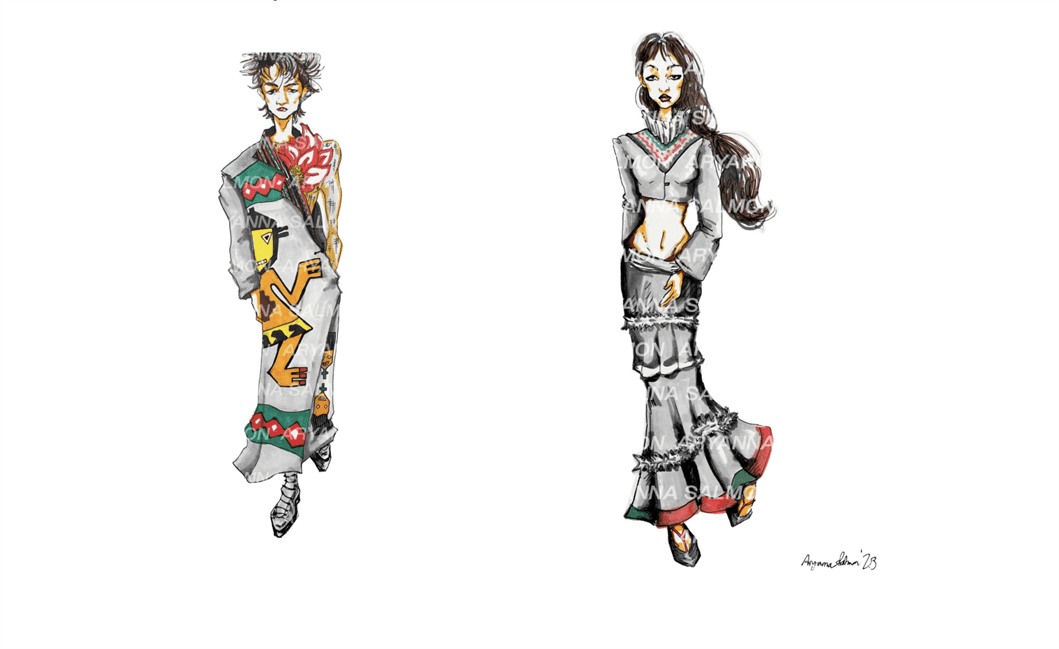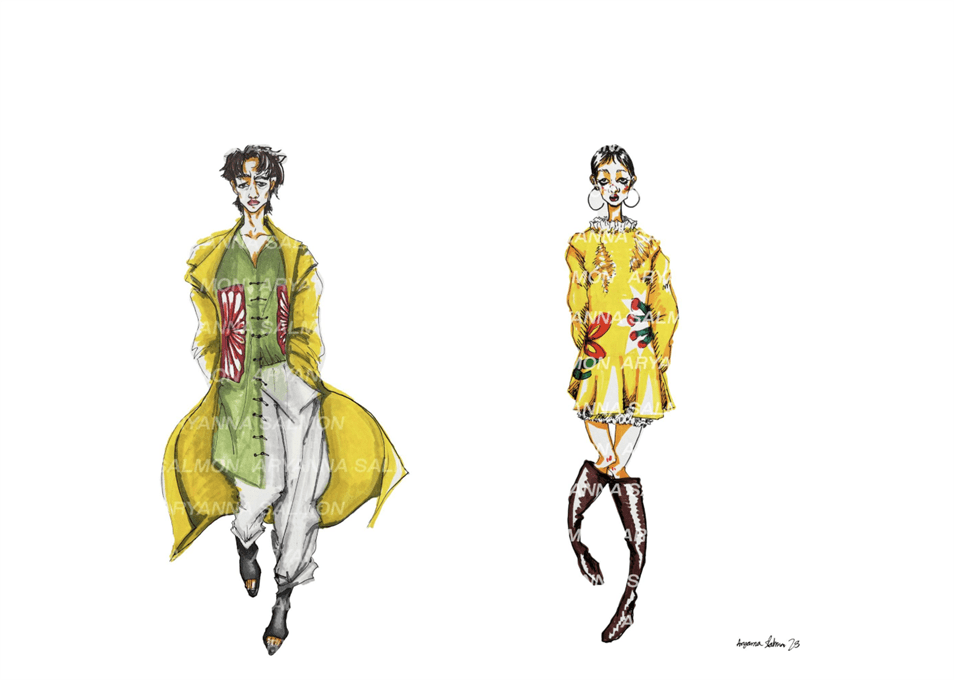Aryanna Salmon was in the middle of creating her collection and she was thrilled to show off her Peruvian-Indigenous inspired designs in an industry that lacks such perspective. But that rush quickly went away when she received the phone call that her mother was in a severe accident overseas in Rome, Italy. The senior fashion design major lost motivation to complete her collection and the only thing that was on her mind was her mother.
“It was her second day in Rome,” Salmon said. “She was on an electrical bicycle tour. It got jammed and she fell on her stomach. And it was so bad that my uncle was there with her and he called my dad and said ‘You and Aryanna need to come.’ The medical workers said it was 50-50. I couldn’t comprehend how a bicycle could do that to someone.”
Not knowing when she would get back, she dropped her tools and booked a one-way ticket to Rome. As her mother was recovering, Salmon still didn’t feel, that what she didn’t know at the time would be a first-place collection at the Newark Fashion Week Festival (NFWF), was even worth finishing.
“When I got home after being in Italy for weeks, I was like, ‘I can’t even think about this competition right now,” Salmon said. “Like my mom, I’m going to need to take care of my mom.”
She then recalled back to when she was a little girl helping her mother sew different garments, patch different fabrics, and make her Halloween costumes and realized one of the reasons why she started this collection was because of her mother’s influence.
Dayana Salmon, Aryanna’s mother, said to her, “Just do it, you never know what could happen.”
Inspired by her mother, after some time, Salmon got back to curating different designs.
She recalled the different times she went to her mother’s hometown in Nazca, Peru back in January of 2022 with her mother, and discovered how much the history and culture weren’t admired or respected.
“Majority of the people there don’t even take care of the ancestral grounds, like the Inca burial grounds in my mom’s hometown,” Salmon said. “There’s trash everywhere, I even saw a Lay’s chip bag near a mummy.”
She hopes that the Peruvian Indigenous people who pioneered many designs are recognized for what they do. Due to the lack of representation, Salmon argues that it sometimes leads Peruvians to disassociate themselves from the culture. Even though the culture and history of Nazca were not admired in her mother’s hometown, Salmon argues that the people who inhabit much power in the fashion industry took credit for what the Peruvian-Indigenous people pioneered. She argues many of the pioneers in the fashion industry are often overlooked for their ideas in designs and when their work finally gets spotlighted on the runway, their counterparts who inhibit much power in the industry take credit for it.
“I would appreciate it if people of power actually gave recognition to the people who were inspired by Peruvians, and gave back to that community,” Salmon said. “I don’t like it when people see traditional designs that they really like, and develop it into something else and take it as their idea.”

Aryanna Salmon, a senior fashion design major, poses for a portrait. Lynise Olivacce | The Montclarion
Wanting to be the change she wanted to see behind and on the runway, she bought a Peruvian blanket which she used in her garments from the time when she was with her mother in Peru. For her final project in her Fashion Illustration course, her professor, Carlos De Moya, challenged his students to have a connection and meaning with their collection culminating in 10 looks. This decision wasn’t too hard for Salmon to make. He expressed having a talent for fashion design is something that often cannot be taught, but something that one exudes in their work naturally. He expressed that Salmon was one of those people. Her collection, Saphi, which means “Roots in Quechua,” was inspired by Peruvian culture and her father who had an “alternative” style.

Aryanna Salmon's, a senior fashion design major, sketch for her collection, Saphi. Here is the blanket inspired but what she received in Peru. Photo courtesy of Aryanna Salmon
“For [my collection] I chose family,” Salmon said. “I chose my Peruvian culture and projected that into my illustrations. My father was very much into metal, so I wanted to combine the alternative side of fashion with my mom’s culture.”
She would say her fashion professor, Dr. May Chae, a professor in digital applications and apparel design, and Professor Sherita Cuffee, a mentor of Salmon’s and gallery coordinator at the Finley Gallery, appreciated her collection and encouraged her to submit it to NFWF. From the times she was helping her mother make garments as a little girl, her walks on the streets of Peru, to her professor’s motivating words, stimulated her incentive to compete and submit some of her looks from her final project in NFWF.
Her illustrations were accepted in NFWF, but that was only half the battle. Making the transition from illustrations to garments for the competition was a challenge that came across Salmon. It was hard to navigate life being a full-time student and working two jobs.
“I felt like I was doing a million things at once,” Salmon said. “It felt like my breaks were being at school and being at work.”
After long months with her mother still in recovery, Salmon still didn’t have much incentive to complete her collection. But her mother refused to let a great opportunity slip away and pushed her daughter to complete it.
In the first week of Sept., she started creating her collection, but couldn’t grasp how she could finish it in time.
“I felt like I was going through a creative block,” Salmon said. “It was taking me like one week to create a shirt and a jacket, and the whole collection needed to be done in three.”

Aryanna Salmon's, a senior fashion design major, sketch for her collection, Saphi. Photo courtesy of Aryanna Salmon
Just as Salmon was a little girl helping her mother make garments, the tables turned in these moments when her mother was getting better enough to help her with sewing and embroidery for long nights. During the time she was making the collection with her mother, she realized the collection had more meaning to it. She realized the collection embodied that there is beauty in the struggle, and that there can be so much to uncover and learn about yourself through adversity.
“I felt like it brought a new meaning to my collection besides it being influenced by my mom’s culture,” Salmon said. “Now it’s knowing the journey/trauma my family and I endured from the accident and my gratefulness that she is still here today. The collection means so much more in that sense of perseverance and the relationship/love I have with my mom, I guess a sort of symbol of mother/daughter love and how grateful I am for having her.”
Salmon explains that she wants people to appreciate the culture and become knowledgeable about where it comes from.
Her collection was the last to show up, and when she saw her collection down the runway it felt like a weight was lifted off her shoulders.
Dr. Chae explains how she was impressed by her creativity and her work ethic on how she was able to execute compelling work, in such a short amount of time.
“I was impressed not only by her creativity but also by her time management that she was able to execute four cohesive garments for about a month to showcase at the Newark Fashion Week Festival,” Chae said. “We always encourage students to participate in design competitions, like Newark Fashion Week, to allow them to gain experience and receive constructive feedback from other professionals.”
Derek Grayson, a senior filmmaking major, is proud of his girlfriend overcoming tragedy in the midst of adversity and sees her having a bright future.
“I have never been more proud of anyone in my life than I am of Aryanna for winning this award,” Grayson said. “The struggles she endured building up to this event and the minimal time she had to complete the pieces made it that more special. When I first saw the designs she drew I was completely blown away by the ingenuity.”
The lack of inclusivity in the fashion industry, and the powerful stories the Peruivan-Indengenious people possess, motivate Salmon to keep their legacy alive, erase stereotypes, and challenge the fashion industry through her collection.
“There’s a lot of erasure within the fashion industry regarding the Peruvian influence in the fashion industry,” Salmon said. “I want to change that in my collection and motivate others to not feel ashamed of where they come from.”



